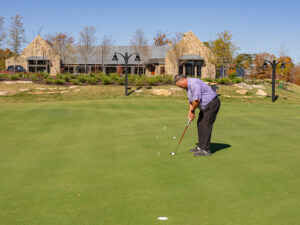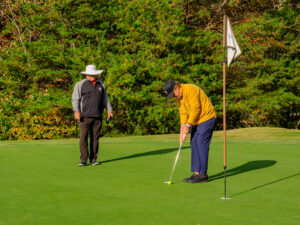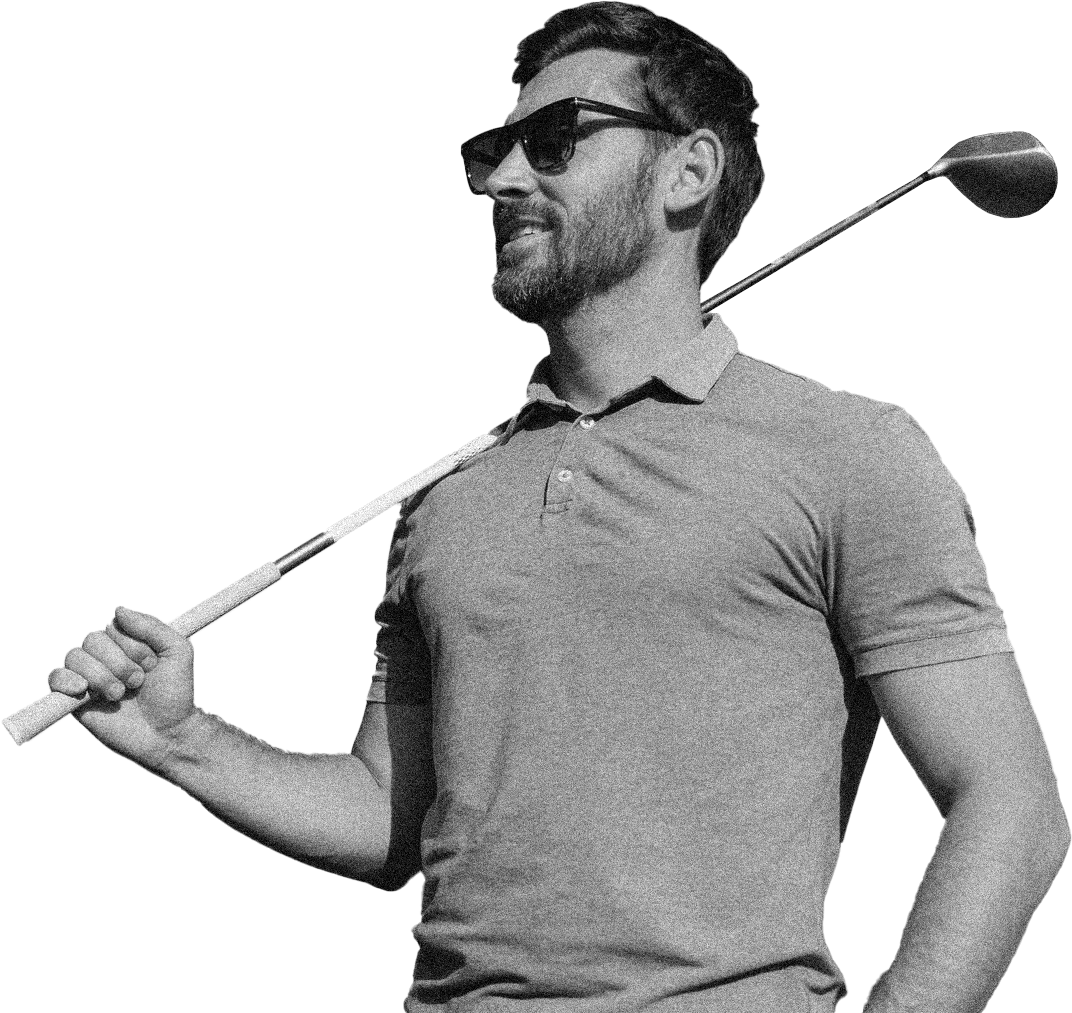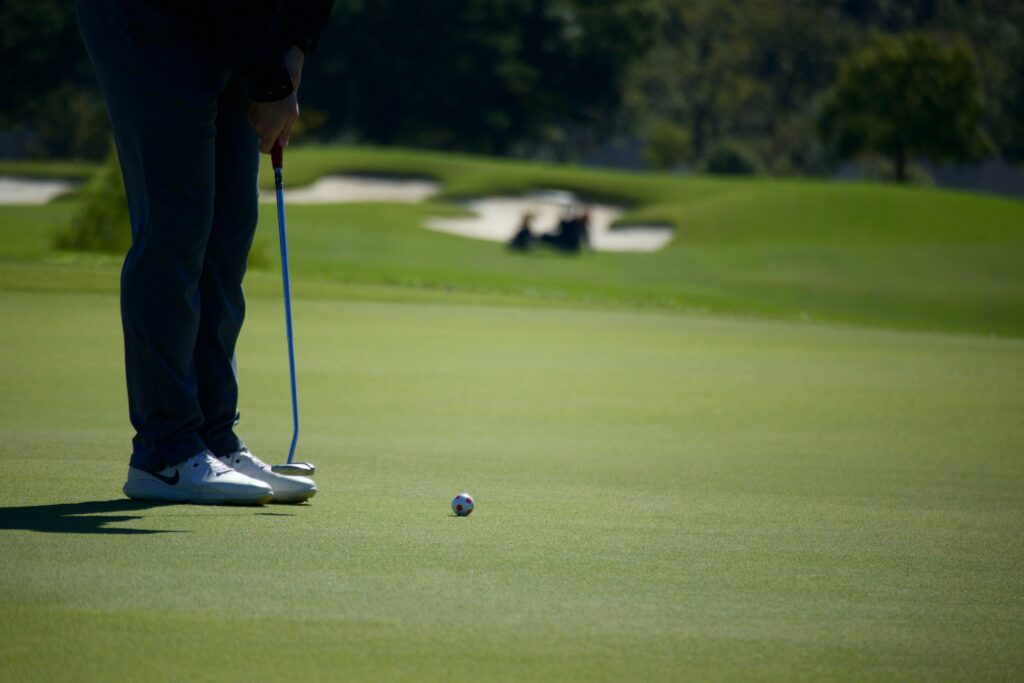At any skill level, improving your putting not only creates lower scores. It builds confidence too! Any golf instructor Orlando worth their salt will point out the importance of building confidence in your putting skills. Let’s explore 6 ways you can build confidence in your putting.
Better Putting Lowers Scores
Do you want to lower your scores right now? If so, why not spend more time improving your putting skills? Very few golfers spend an equal amount of time practicing their putting as they do their ball striking. This is evident by what I see daily at our practice facility. Yet, the total number of putts within any given round make up at least 40% of a high handicapper’s score.
Without a doubt, every client I’ve assisted over my career has benefited by becoming a better putter. Strokes gain statistics does show ball striking is skill #1 to conquer. However, there is an underlying tone to the game of golf that places a lot of pressure and emphasis on a golfer’s ability to do one thing, get the ball in the hole. And the closer a golfer gets to the hole, the more anxiety creeps into any golfer’s game.
Each of the 6 ways to build confidence in your putting can eliminate anxiety, improve skills, and lower scores.
Better Putting Tames Anxiety
Anxiety can lead to not trusting yourself or your equipment. It can lead to becoming mechanical with your stroke and process. It can make you search for perfection and create tension. It can also lead to being over analytical golfer.
Within this month’s blog post, you’ll discover a couple of new thoughts and strategies we haven’t covered in the past. As well as reviewing some old material you may have forgotten about or have neglected to see value in previously, related to the 6 ways to build confidence with your putting.
1.Fit and Trust Your Equipment
Properly fitted equipment will make a big difference in your success as a putter. Having your putter set at the correct lie and loft angles as well as the proper length of shaft provides you an opportunity to set up to every putt consistently. And setting up consistently helps you avoid being mechanical with your stroke. Also worth noting, this style of putter you choose can make a difference in your success as a putter. Understanding the unique arc that you’re putting stroke makes assists with choosing whether you need a blade putter or a mallet putter. Mallet putters tend to create a more stable face at impact and in turn and the potential to strike the ball more consistently. But someone who’s arc has more curvature can benefit from the design of a blade putter. My suggestion is to be fitted for a putter by a professional club fitter who specializes in fitting putters.
2. Stay Away from Mechanical Thoughts
It’s easy to get your brain clouded with all the different thoughts that go in to comprising a perfect putting stroke. That these mechanical thoughts inevitably create and inconsistent putting stroke. Particularly if these thoughts are randomized each time you attempt a putt. Combine this confusion with the randomness of distance each putt must roll and suddenly, the mechanics are undependable. It’s best that once you have a consistent setup, trusted! Your pre-shot routine is the putting system you need to eliminate the mechanical thoughts. And in turn allow you to feel puts versus mechanically create putts.
3. Embrace Feel
Are you a creative person or a technical person? Are you someone who believes you’re artistic? Or are you someone who is always analyzing? Regardless of which side of the isle you are on related to how you play golf, you must accept and embrace the fact that putting is all about feel:
Feel for the Middle of the Putter Face
Like any other golf shot, great putting starts with the ball making solid contact with the center of the putter face. Without centered contact, your ability to control distance and direction is severely limited. There’s lots of drills to help you find the middle of the putter face. Whether it’s placing rubber bands around the putter to highlight middle. Or using another swing aid that not only identifies but heightens the feel of hitting the sweet spot of the putter. It’s extremely important that you learn to hit the sweet spot of your putter every time you make a stroke.
Feel for Speed and Distance Control
Once you learn to hit the middle of your putter face every time, it’s now time to gain feel for your most organic way of creating speed or distance control.

Controlling speed has a lot to do with the rhythm and tempo of your stroke. But it also has a lot to do with how you envision your putts landing in the hole. Some golfers like to see the ball roll in with authority. Others like to see the ball die into the hole. This is more of a personal preference based on how creative or how analytical you are as a golfer. Siding on the creativeness you possess will always provide you the ability to feel the speed of your putts more consistently.
Each time you go to practice your putting. Or when you’re getting ready to play your next round of golf. It’s important that you stay consistent with your strategy of speed and distance control. Determine how your strategy will work on the greens you’re about to practice or play on. Often, high handicap amateur golfers sacrifice their skill and strategy to control rhythm and tempo because of the change of speed of greens. Having a consistent strategy for speed and distance control allows you the ability to alter from your standards slightly to accommodate the difference in green speeds.
For example, if you’re putting faster greens and you like to see the ball hit the hole with authority, lessening your grip pressure at setup could allow you the ability to maintain your speed strategy while being able to control your speed on the faster green surface.
Feel for Slope and Direction
It’s not until you gain a consistent strategy and feel for speed that you can now more accurately feel and predict the slope of a green. And the direction a putt will take.
Remember, the faster the put travels the less it will curve. The opposite is true, the slower big puck rolls the more it will curve. Using this absolute along with your consistent strategy of speed control now allows your creativity to not only see the direction of put will take. It will also allow you to feel the direction.
Feeling the direction has a lot to do with visualizing what the puck will do and how the putt will roll. You’ll also have to feel slope. Feeling slope for the most part takes place in your feet. Feeling how one side of the putt might be higher than the other. Or feeling that the slope takes your putt down a hill versus upper hill.
The combination of feeling slope in your feet along with your consistent strategy of speed control now allows you to envision the exact place the ball will start curving towards the hole.
Feel the Merger and Connection of all 3 Together

It’s not until you can put centered contact, speed and distance control, and the feel for slope and direction together that you become a great putter. This takes time. It takes a lot of effort. But it takes a lot of
feel. And feel is always the last thing to be developed in your golf game. Particularly with putting and short game.
Ask any touring professional and they’ll tell you “feel is the last to arrive to their party. And the first to leave their party.” Meaning, it takes a long time for them to create feel using practice and experience to consistently monitor and evaluate their ability to feel. But once they stop practicing, feel immediately starts dissipating. And the longer period in between practice sessions, the more feel is lost in their games.
To become a better putter, you must work on all three skills separately and together.
4. Become a Better Green Reader and Visualizer
As human beings we are gifted with the ability to see things in three dimensions. It’s your duty to utilize this skill to the best of your ability to calculate and envision how a ball will roll to a hole from anywhere on the green.
We’ve already covered how to feel the slope with your feet. But how do you take that feeling and create a visualization understanding all three dimensions of the putt? It’s extremely hard to do so if you never see all three dimensions. And if you’re somebody who stays behind the ball only to read a putt, You are missing two of the three dimensions.
To become a better green reader and visualize roll, you’ll need to see and read each putt you attempt from three different angles:
Down the Line
This angle is where most golfers try to read a putt. And they do not read the putt from anywhere else. If you believe this is the only way to read a putt, then you need to back away from the ball and put more

distance between you and the ball than you believe is needed.
If you’re kneeling, standing, or crouching behind the ball with not enough distance for your 2 eyes to see the ball in relation to the hole, you’re doing yourself an injustice. Back up an extra 5 feet the next time you’re reading a putt. Or even 10 feet. When you do, you’ll notice you see more break. In my opinion, this is the biggest cause of any golfer under reading a putt.
Standing too close to the ball when reading a pub from behind the ball. Give yourself more space between you and the ball, and your eyes will receive more information.
From the Low Side of the Putt
From behind the ball it should be easy to determine which is the high side and the low side of the intended line of any putt. Obviously, the low side is where the ball will roll to as it approaches the hole. It’s from the low side that you can see three distinct data points:
-
- The total length of the putt – if I handed you a putter lengthwise and asked you to estimate the length of the shaft, you’d have a hard time doing so. But if I handed you the putter sideways and asked you to guess the length of the shaft, it’d be a lot easier. Why? Because you see the entire length of the shaft from that angle. Step to the low side of the putt with plenty of distance between you and the intended line of the putt. Doing so provides you an opportunity to see and more accurately estimate the total length of any putt.
- The slope of the putt – from behind the ball you may be able to determine whether you have an uphill or downhill putt. But that’s not enough information. Standing to the low side of the putt line, you get to see how much slope is involved. Whether going uphill or downhill. Why would you not want this information as you’re calculating how much distance will be needed to reach the hole? 1° more slope, uphill or downhill, can make a big difference in distance control of any putt.
- Contrasting features – from the low side of the putt, there’s a lot of contrast and color differentiation that provides your eyes a lot of extra information. This extra information assists in your green reading. Items such as grain, the amount of grain, where slopes peak, and other smaller nuances of the putt become evident when reading your putt from the low side. When you have the time, compare the low side view to the high side view. When you do, you’ll realize the high side looks plain with very little detail. The low side will always provide you the extra details to be more precise with your green reading.
From Behind the Hole
Some golfers will argue that reading a putt from behind the hole provides the truest read possible. Why? Because the hole becomes the objective. Not the ball. If you were to read the putt from behind the ball and then from the low side, and walk behind the hole afterwards, all the information you gathered from the other two directions tend to be confirmed. Simply because you’re looking at the hole, backwards towards the ball. If you’re reading the putt from the low side, you’re halfway towards walking behind the hole. Why not take the extra steps to confirm what you see from the first two views? As well as to clear a path to envision how the ball will roll into the hole.
Now it’s time to visualize the roll of the putt. Having enough information in your brain about the speed, direction, and the apex of the putt, you should be able to close your eyes and envision how the ball will roll to the apex point. How it curves towards the hole from the apex point. And how the ball ultimately lands inside the hole.
Visualizing the line of the putt, the speed of the putt, from behind the ball, is something all great putters do. Doing so provides a sense of calm and confidence. Walking into your putt and setting up for success is easier when you’ve envisioned how you see the putt rolling into the hole.
Always take a few moments to visualize the ball rolling smoothly into the hole. Imagine the ball rolling on its intended line and sinking into the hole. You’ll be surprised how much envisioning your putt rolling into the hole well actually assist with you becoming a better putter.
5. Practice
Doctors practice medicine. Attorneys practice law. Golfers must practice golf. And like the other disciplines mentioned, there are various skills each practitioner must master to insure they become an expert at their craft. Why not spend more time practicing your putting? It can’t hurt. And why not find a golf instructor in Orlando that can assist you with doing so?
Consistent practice is essential to building confidence on the green. The more you practice your putting, the more confident you become. Set aside time to work specifically on your putting. Focus on repeating the same process of green reading with each putt. As well as the process of set up, and in turn, stroke. Doing so will build the consistency you’re trying to obtain.
Get creative with your putting practice. Putting practice does not have to be as mundane as it seems. Create simulated games on the practice screen to help you deal with situations you encounter on the golf course. If you’re a lousy putter going down a hill, create games putting down a hill to help improve that skill. Create games that reward putts you hole. Or reward fantastic distance control. The more fun you make your practice, the more fun and confidence you’ll have when on the golf course.
6. Commit!
Being committed to improve any skill is a must. I take pride in knowing that all my clients are committed golfers. Their level of commitment varies based upon their life priorities, their competitiveness, and their inner competitiveness. But bottom line, they’re committed to their improvement.
To become a better putter requires a commitment to improve your putting skills. Sometimes the smallest of commitments can produce disproportionately bigger and better outcomes. Find ways for you to be more committed to becoming a better putter. Doing so will make it easier to maintain a positive attitude about your pudding. And deflects negative self-talk on the green.
Conclusion
Remember, golf is a game and it’s important to enjoy the process, even when things don’t go as planned. The 6 ways to build confidence in your putting can assist you with improving your skills. And enjoying the game of golf even more. You should look to choose a golf instructor Orlando that can assist you with improving your putting skills.
Commit to become a better putter so you increase your enjoyment of game. Committing to becoming a better putter improves your ability to stay positive throughout around. And with committed practice of the various skills that comprise putting, will lower your scores! These 6 ways to build confidence in your putting is only the beginning.






